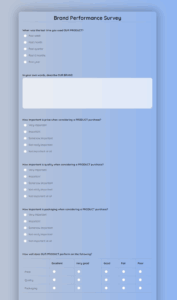Ever wondered how your customers truly feel about their interactions with your business? Getting feedback is crucial, but it doesn’t have to be a complicated, time-consuming ordeal. In fact, some of the most powerful insights come from keeping things straightforward and easy for everyone involved.
A well-designed simple customer service survey template can be your secret weapon. It allows you to quickly gauge satisfaction, identify pain points, and understand what’s working well, all without overwhelming your customers or your team. The goal is to gather actionable data efficiently, ensuring that every interaction you have with your customers is a step towards building stronger relationships and a better experience.
Why Simplicity Is Your Best Friend in Customer Feedback
In today’s fast-paced world, people have less time and patience for long, convoluted questionnaires. When you present a customer with a sprawling survey, you’re not just asking for their feedback; you’re asking for a significant chunk of their valuable time. This often leads to survey fatigue, incomplete responses, or worse, no response at all. The beauty of a simple customer service survey template lies in its brevity and clarity, encouraging higher completion rates and providing more authentic insights.
Think about it: a customer who just had an issue resolved or a smooth purchase completed is more likely to spend thirty seconds sharing their immediate thoughts than five minutes filling out a detailed form. These immediate, unvarnished responses are incredibly valuable because they capture the sentiment right when it’s strongest and most relevant. It’s about making the feedback process as frictionless as the service experience you aim to provide.
Moreover, simpler surveys are easier to analyze. When you have fewer questions, the data you collect is less cluttered, making it easier to spot trends, identify recurring issues, and pinpoint areas for improvement. This streamlined analysis means you can react faster, implementing changes more swiftly and demonstrating to your customers that their voice truly matters. It transforms feedback from a chore into a powerful tool for continuous improvement, allowing you to iterate and refine your service offerings based on real-world experiences.
Beyond just data collection, a simple survey reflects positively on your brand. It shows respect for your customer’s time and demonstrates an understanding that their primary interaction with you should be about solving their needs, not just providing you with information. This thoughtful approach can enhance customer loyalty and perception, making them feel valued rather than just another data point.
Core Elements of an Effective Simple Survey
So, what exactly makes a simple customer service survey template effective? It boils down to asking the right questions in the fewest possible words. The key is to focus on questions that provide clear, actionable insights without requiring extensive thought or effort from the customer. Here are some fundamental elements you should consider:
- **Overall Satisfaction Rating:** A quick 1-5 star rating or a scale of “Very Unsatisfied” to “Very Satisfied.” This gives you a broad overview of their experience.
- **Net Promoter Score (NPS):** “How likely are you to recommend our company/product/service to a friend or colleague?” on a scale of 0-10. This is a powerful indicator of loyalty and growth potential.
- **Customer Effort Score (CES):** “How easy was it to handle your request?” or “How much effort did you personally have to put forth to handle your request?” on a simple scale. This highlights friction points in your processes.
- **Open-Ended Feedback (Optional but Recommended):** A single text box asking, “Is there anything else you’d like to share about your experience?” or “How can we improve?” This provides qualitative insights that can explain the quantitative scores. Keep it optional to maintain simplicity.
Putting Your Simple Survey to Work
Having a fantastic simple customer service survey template is only half the battle; the real magic happens when you effectively deploy it and, most importantly, act on the insights you gather. The deployment method can significantly impact your response rates. Consider sending your survey immediately after a customer interaction, such as after a support call, a chat session, or a purchase. This immediacy captures the customer’s experience while it’s fresh in their mind, leading to more accurate and detailed feedback.
Automating the survey distribution is crucial for consistency and efficiency. Integrate your simple customer service survey template into your CRM or helpdesk system so that it’s triggered automatically following specific events. This ensures that every relevant interaction is followed up on without manual effort, creating a seamless feedback loop that continuously informs your service improvements. Email is a common method, but in-app prompts or SMS messages can also be highly effective, depending on your customer base and their preferred communication channels.
Once the responses start rolling in, the next step is diligent analysis. Don’t just collect data; interpret it. Look for patterns in the satisfaction scores, identify common themes in the open-ended comments, and track trends over time. Are certain service agents consistently receiving high marks? Are customers repeatedly encountering the same issue with a specific product or process? These insights are gold mines for identifying areas of strength to leverage and weaknesses to address promptly. Prioritize the issues that have the biggest impact on customer experience and loyalty.
Finally, and perhaps most critically, you must act on the feedback. A survey is not just a data collection exercise; it’s a promise to your customers that you care about their experience and are willing to improve. Whether it’s training your team on common pain points, refining an internal process, or updating your FAQs, taking concrete steps based on customer input is essential. Communicate these changes back to your customers whenever possible; it reinforces their value and encourages continued engagement with your feedback mechanisms. This continuous cycle of listening, learning, and improving builds trust and reinforces your commitment to exceptional customer service.
Implementing a straightforward feedback mechanism truly empowers your business to stay attuned to the heartbeat of your customer base. It’s about fostering an environment where customer voices are not just heard, but actively sought out and used to shape a better experience for everyone. This proactive approach to understanding and addressing customer needs is what sets leading businesses apart.
By consistently gathering and acting on insights gleaned from concise, well-crafted questions, you create a powerful cycle of improvement. This dedication to understanding and responding to your customers’ experiences is key to building lasting loyalty and ensuring your service continually evolves to meet and exceed expectations.



